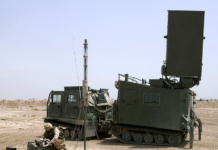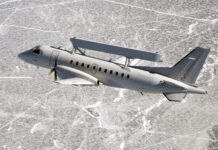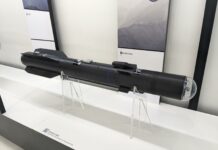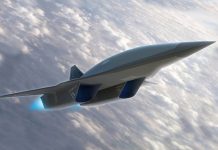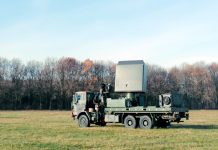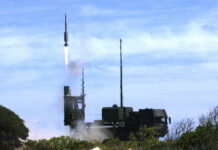For many decades, one of the main characteristics of most land, sea, and airborne radars was the use of a moving antenna. Mechanical movement was needed either to survey an area of terrain, sea or sky, or to direct the radar to a specific target.
In the case of airborne radars, this moving antenna was housed either in a radome, or in a slowly-turning rotodome. Although many modern airborne radars still retain this type of antenna, designs that represent the state of the art use electronically-scanned arrays able to form and steer their radar beams.
The high-power transmitter and receiver sections of a mechanically-scanned radar are connected to the antenna via waveguides or a similar feed systems that incorporate some form of flexible section in order to allow for antenna movement. This technique imposes signal losses as the transmitter output travels to the antenna, and further losses as the received signal travels from the antenna to the radar’s receiver.
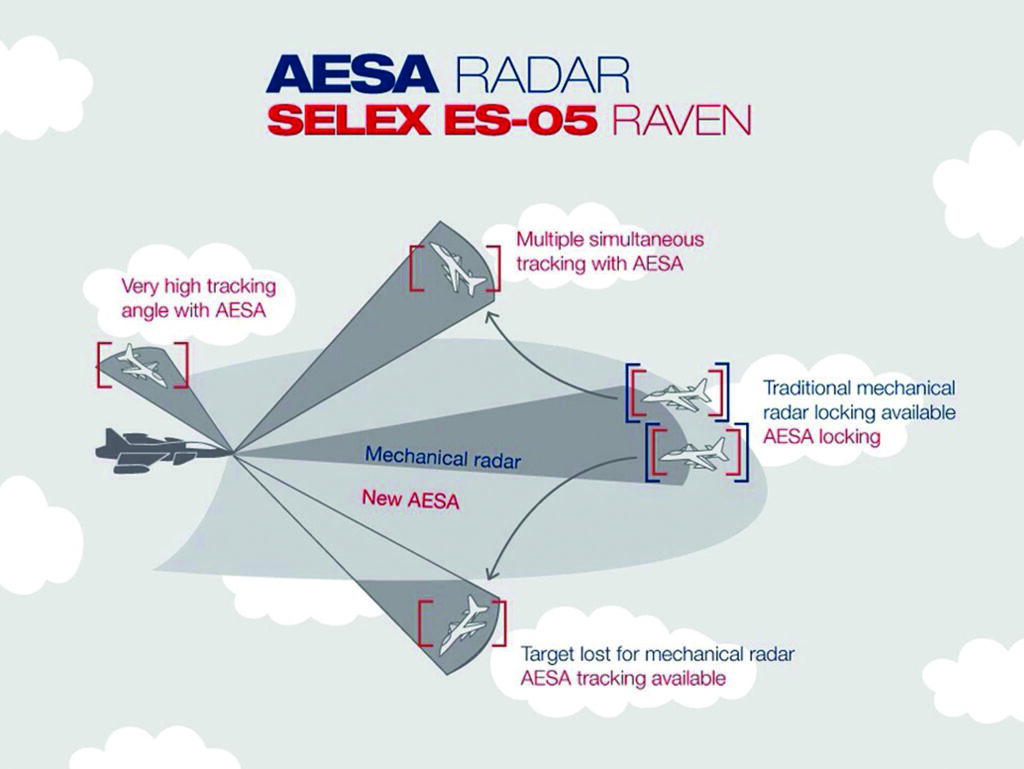
Building an antenna in the form of an array of modules allows the beam to be steered electronically. At first, this was done by creating a passively-scanned array that was connected to traditional transmitter and receiver subsystems. But radars using passive electronically-scanned array (PESA) technology still suffered from signal losses, and faced the reliability problems traditionally associated with high-power transmitters.
In a PESA array, the primary function of the modules is to generate the phase delays needed to create the beam. In an active electronically-scanned array (AESA), each transmit/receive (TR) module handles its share of the energy-generating and receive functions, eliminating the signal losses caused by the signals’ journey to and from the antenna.
In some cases, an AESA radar is designed ‘from scratch’ as a totally-new item, but an alternative route is to replace the antenna, transmit and receive sections of an existing radar with new AESA hardware, but to retain the ‘back end’ subsystems that process the received signals.
One potential problem with electronically-scanned antennas is that they may act as a reflective surface that will increase the fighter’s radar cross-section. One solution is to position the array with a tilt, but since electronically-scanned arrays have a lower performance against off-boresight targets, the radar’s performance against targets approaching from directly ahead will be degraded. Some radars such as CAPTOR-E (on the Eurofighter TYPHOON) and ES-05 Mk 5 (on the JAS 39 GRIPEN E/F) are mounted on a repositioning mechanism that can steer the array towards an area of interest, including high angles away from the aircraft centreline.
AN/APG Radars
The first operational fighters to have an AESA radar were a batch of 16 F-15C deployed at Elmendorf Air Force Base late in 1999. They were fitted with the Raytheon AN/APG-63(V)2, a radar whose antenna had more than 1,000 T/R modules, and offered a performance better matched to the capabilities of the AIM-120 medium-range air-to-air missile. It also provided a non-co-operative target recognition (NCTR) function.
By using an improved T/R module developed for the AN/APG-79, plus a new array power supply, the follow-on AN/APG-63(V)3 radar could be made lighter than the (V)2. System development started in 2008, and the (V)3 is now in service on some USAF and Air National Guard (ANG) F-15s. Other users include Saudi Arabia and Singapore. The (V)3 will also be used on the F-15QA fighters that Qatar has ordered for delivery in 2022.
Based on an antenna array with 1,500 T/R modules, the Northrop Grumman/Raytheon AN/APG-77 carried by the Lockheed Martin F-22 uses the host aircraft’s computer hardware rather than dedicated radar-mounted LRUs for its signal and data processing functions. The radar entered service having only air-to-air modes, but SAR and MTI air-to-ground modes are were introduced by the AN/AGP-77(V)1 radar on Lot 5 aircraft.
Initial deliveries of the F/A-18E/F SUPER HORNET were with the mechanically-scanned Raytheon AN/APG-73 multimode radar, but the Block 2 version of the aircraft introduced an Enhanced Forward Fuselage (EFF) designed to house Raytheon’s AN/APG-79, which uses an AESA array made up of 1,100 T/R modules. Operating over a wider bandwidth than the AN/APG-73, the -79 has a high level of frequency agility. The AN/APG-79(V)X version announced in 2005 was designed to be compatible with the F-18C and -18D, and can be used to upgrade these older aircraft. It has a greater air-to-air range that is available from the aircraft’s original AN/APG-65, and can handle simultaneous air-to-air and air-to-ground missions.
In 2014, Raytheon announced the AN/APG-79(V)4. a version whose smaller-diameter AESA array is compatible with the nose of older-model F-18s, but which retains the proven ‘back end’ of the full-specification radar. Flight testing was concluded in 2015, and in 2019 the company was awarded a contract to install the (V)4 on the F/A-18C/D fighters of the US Marine Corps.
Developed for the United Arab Emirates, the F-16E (single-seat) and F-16F (two-seat) DESERT FALCON versions of the aircraft are equipped with the Northrop Grumman AN/APG-80 AESA radar. According to Northrop Grumman, this has a much greater detection range and a two-fold increase in reliability compared to mechanically scanned radars.
The Northrop Grumman AN/APG-81 dual-mode radar for the F-35 forms part of an integrated sensor suite that includes the Northrop/Lockheed Electro-Optic Targeting System (EOTS). Its integrated RF system/multifunction nose array has 1,200 T/R modules, and acts as a multi-function aperture (MFA) that handles traditional air-to-air and air-to-surface radar functions, plus a full suite of electronic warfare functions. The latter was probably the first example of a fighter-mounted radar being given an electronic-attack function.
A drastic modernisation of the AN/APG-63 resulted in a AESA-based configuration originally known as the AN/APG-63(V)4, but subsequently redesignated as the AN/APG-82. Expected to replace the existing AN/APG-70 radar of the USAF’s F-15E, it combines the antenna and power supply of the AN/APG-63(V)3 with a radar receiver/exciter and Common Integrated Sensor Processor based on similar hardware used by the AN/APG-79. New radar frequency tunable filters are intended to allow the aircraft to operate its radar and EW systems simultaneously, and the radar should permit the near-simultaneous interleaving of some air-to-air and air-to-ground radar modes.
The Scaleable Beam Radar
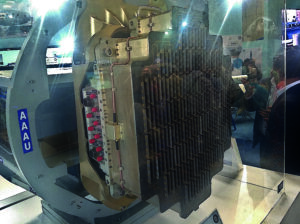
Launched with an eye to the F-16 retrofit market, Northrop Grumman’s AN/APG-83 Scaleable Agile Beam Radar (SABR) was designed to be compatible with the existing electrical and physical interfaces of the F-16, as well as the aircraft’s existing levels of power and cooling capacity.
In 2013, the radar was selected for retrofit to USAF and Taiwanese F-16s, and in 2015 it was chosen by Singapore for its planned F-16 upgrade. 2017 saw the radar chosen as part of Greece’s F-16 upgrade to the Block V configuration, and Bahrain announced that the AN/APG-83 would be retrofitted to its F-16 fleet as part of the Block V upgrade, and fitted to a batch of new-build Block V aircraft also being procured. A US$244M contract to retrofit the AN/APG-83 to 72 US ANG F-16s was awarded in May 2017
The Raytheon AN/APG-84 Advanced Combat Radar (RACR) was designed to be a drop-in upgrade for the F-16 and F/A-18. To make the set compatible with existing onboard power supplies and cooling systems, its antenna T/R modules are cooled by a liquid-to-air heat exchanger rather than a conventional liquid-cooling system. In 2013, the AN/APG-84 was selected by South Korea as a retrofit for its F-16 fleet, but the resulting order was cancelled in the following year due to rising cost.
The CAPTOR-E Radar
Having explored AESA technology under the European AMSAR (Airborne Multi-Role Solid State Active Array Radar) programme, the Euroradar consortium developed the CAPTOR-E radar, which combines an AESA antenna and front end with the back-end of the earlier ECR-90 CAPTOR-M mechanically-scanned radar that had been developed for the Eurofighter TYPHOON. An antenna with a diameter of about 600mm is populated by around 1,400 liquid-cooled T/R modules. This is mounted on a gimbal repositioning system able to point the array in wide off-boresight angles. A contract for the final development and integration phase of the CAPTOR-E was awarded in 2014. The new radar will be introduced during the aircraft’s Tranche 3 production phase.
Germany and Spain have agreed to finance the development of an improved AESA radar for use on their respective Typhoon fleets. This will involve new hardware, including a digital multi-channel receiver and redesignedT/R modules for the antenna. The project will be carried out by a Spanish-German industrial consortium led by Hensoldt.
When the Dassault RAFALE entered service in 2001, it was equipped with the Thales RBE2 (Radar à Bayalage Electronique deux plans). This uses a passive electronically-scanned array, but R&D work on an AESA began in 2002. Flight testing of the resulting RBE2-AA initially used T/R modules of US manufacture until Thales-developed hardware became available.

The basic version of the RBE2 AESA entered service in 2013, and in the following year, France’s procurement authority DGA placed a contract for what would become the F3R standard of RAFALE. This version would have an improved variant of the radar for aircraft destined for France, Egypt, India, and Qatar. Production of the RBE2 was expected to run until 2020, and could be extended in the event of further orders being placed for RAFALE.
Leonardo’s GRIFO-E is a relative newcomer. Announced in 2018, the radar is currently in a development phase due to end by 2021. It consists of an AESA-based antenna with around 600 T/R modules based on gallium nitride technology rather than the more common gallium arsenide, and two subassemblies – a receiver/exciter/processor, and a power supply.
The current PS-05 Mk 4 radar of the Saab JAS39 GRIPEN uses a mechanically-scanned antenna, but Saab Electronic Defence Systems has developed the ES-05 Mk 5 AESA radar for the GRIPEN JAS-39 E/F as well as future GRIPEN upgrades. Based on gallium nitride technology, this also draws on experience gained from the earlier Not Only a RAdar (NORA) demonstrator programme.
The IAI / Elta Systems EL/M-2052 is the first Israeli-developed AESA radar for fighters. Flight trials started in 2006 aboard a Boeing 737 testbed. The T/R modules in the antenna array are packaged into ‘bricks’ each made up of 24 modules. This configuration allows the creation of antenna arrays consisting to the maximum number of ‘bricks’ that can be housed in an aircraft’s nose. This makes it relatively easy to reconfigure the radar for new-build or retrofit applications.
In 2015, Elta and Hindustan Aeronautics Limited (HAL) signed an agreement to develop an improved version of the EL/M-2052 for use on HAL’s TEJAS lightweight fighter. By 2017, an EL/M-2052 was flying on an Indian Air Force Jaguar strike fighter as part of a plan to retrofit the radar to around half of India’s JAGUAR fleet. In the following year, a contract to supply imported and locally-built radars for the TEJAS 1A was reported.
For the planned HAL TEJAS Mk2 fighter, LRDE India is developing the UTTAM multi-mode AESA radar. This will be teamed with other sensors including an infrared search and track unit and a missile approach warning system, in order to create a data-fused system.
Russian Developments
Early Russian electronically scanned radars for fighters such as the V Tikhomirov Scientific-Research Institute of Instrument Design (NIIP) N007 ZASLON PESA radar for the MiG-31 FOXHOUND used PESA technology. Experience gained from the development of the ZASLON allowed the organisation to use a PESA array for the N011M Bars adopted for India’s Su-30MKI. The first Russian radar to use an AESA antenna was probably the Phazotron Zhuk-AE first displayed in 2005.
Russia’s most advanced AESA radar is the Sh-121 being developed by NIIP for the Sukhoi Su-57 PAK FA fighter. The main forward-looking array is the N038 X-band antenna based of gallium arsenide T/R modules. Flank-mounted secondary arrays are used to extend the angular coverage in the azimuth plane, while at least one more array provides rearward coverage that may allow ‘over-the-shoulder’ missile engagements. The function of L-band arrays built into the wing leading edges of the aircraft remains unclear. They may have an IFF function, or could be intended to provide a limited capability against low-observable aircraft.
Sometimes referred to as the Type 1478, the Nanjing Research Institute of Electronic Technology (NRIET) KLJ-7 uses a mechanically-steered planar array antenna, and was developed for use on the JF-17 fighter, while the KLJ-7V2 is a higher-powered model reported to be carried by the JF-17 Block 2. The follow-on KLJ-7A uses either a single mechanically-steered AESA (a version thought to be intended for the JF-17 Block-3) or one frontal antenna and 2 lateral arrays. Both models of KLJ-7A have a track-while-scan capability.
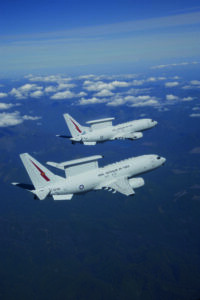
The US Air Force and Navy pioneered the concept of airborne early warning (AEW) aircraft, and as a result, the Boeing E-3 and Northrop Grumman E-2 Hawkeye entered service with mechanically-scanned radars. However, the E-2D Advanced Hawkeye introduced the AN/APY-9 radar, whose antenna is electronically scanned in elevation, and uses a combination of mechanical and passive electronic scanning for azimuth coverage.
When Australia issued a requirement in 1995 for a next-generation AEW aircraft, Boeing responded with its 737 AEW&C twin-engine airborne early warning and control aircraft. Selected to enter Australian service as the E-7A WEDGETAIL, this carries the Northrop Grumman Electronic Systems L-band Multi-role Electronically Scanned Array (MESA) radar. This uses a 7.3m x 2.7m AESA array mounted in a dorsal fin on top of the fuselage to provide 120 degree coverage on both sides of the aircraft, while a ‘top hat’ supporting array covers 60 degree sectors facing fore and aft. In addition to serving as a radar sensor, these arrays can also be used in the passive elint role.
Technical problems delayed the aircraft’s debut by three years. Deliveries started in 2009, and initial operational capability was achieved in November 2012. Turkey was the first export customer, receiving the last of a batch of four at the end of 2015. South Korea ordered four, and received these in 2011-12. The UK ordered five in 2019, and deliveries are due to end in 2026.
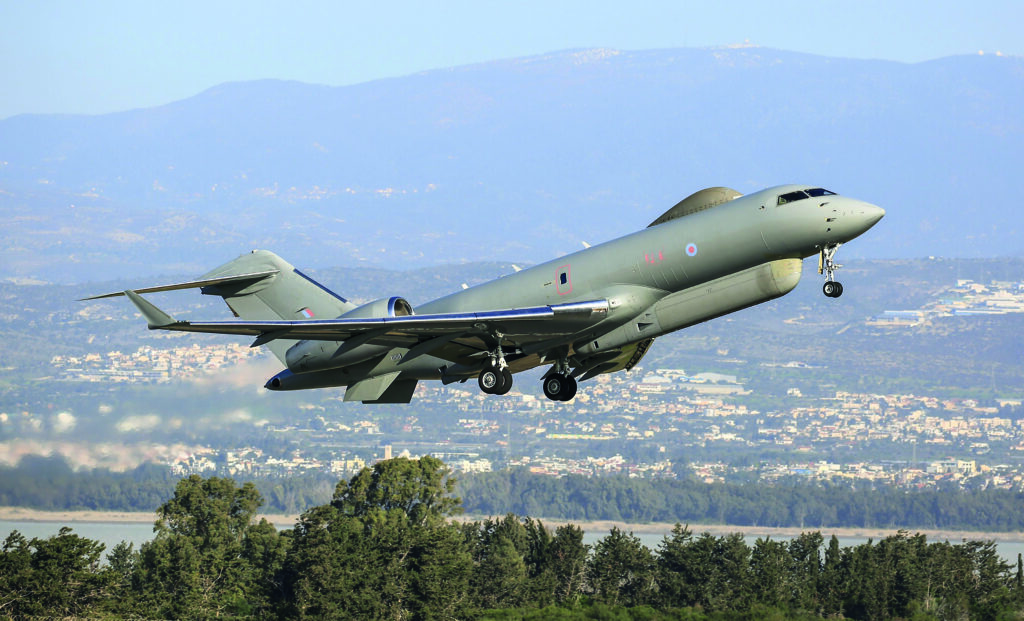
Russia’s equivalent to the E-3 SENTRY is the BERIEV A-50 AEW aircraft. This uses a pulse-Doppler SHMEL radar operating in S-band. The antenna is housed in a dorsally-mounted rotodome, and uses mechanical scanning in azimuth, and electronic scanning in elevation. An upgraded SHMEL-M was subsequently developed as part of the A-50U upgrade. A SHMEL-2 version developed for a second-generation A-50 variant is reported to match the performance of the US APY-1/2 radar system. A new AESA-based version of the SHMEL radar is under development for the Ilyushin A-100, an AEW variant of the PS-90 engined II-476 transport aircraft.
A dual-face flat panel AESA array operating in S-band forms the basic of the Saab Electronic Defence Systems Erieye PS890 dorsally-mounted radar carried Swedish Air Force Saab S-100B AEW aircraft. Data from the aircraft is downlinked to Sweden’s air-defence system. The ERIEYE radar is also carried by Brazil’s EMB-145SA AEW aircraft. An extended-range ERIEYE ER radar has been developed for the Saab GlobalEye Bombardier Global 6000 business jet-based ISR platform. This is reported to offer a 70% increase over the 250 km range of the earlier version.
Elta Systems has created a series of AEW radars based on flat-panel arrays. At least three variants are known to exist. The EL/M-2075 is a first-generation system used by Chile on its Boeing 707-385C CONDOR. It has three L-band AESA arrays – one in the aircraft’s nose, and one on other side of the forward fuselage. Working together, the three provide a total of 280 degrees of azimuth coverage.
For the EL/M-2085, Elta opted for a lighter-weight configuration based on nose and tail-mounted radomes with L-band antennas for long-range detection, and dual side-fuselage S-band antennas for higher accuracy. Fitted on GULFSTREAM G550 platforms operated by Israel and Singapore, the system includes a processing-intensive ‘track-before-detect’ mode intended for use against stealthy low-observable air targets. When developing the EL/M-2090 for use on Indian Air Force BERIEV A-50Ehl aircraft, the company adopted three arrays mounted in a triangular configuration within a dorsal rotodome above the aircraft’s rear fuselage.

The USAF’s E-8 Joint STARS ground-surveillance aircraft uses an AN/APY-7 X-band radar, whose antenna is mounted in a canoe fairing beneath the aircraft’s forward fuselage. The beam is electronically steered in azimuth, and mechanically in elevation. While still under development, the aircraft was used operationally during Operation Desert Storm in 1991 and Operation Joint Endeavor in 1995. Deliveries of production aircraft started in 1996, and the type has been used in support of the Kosovo War in 1999, then in Operation Enduring Freedom, Operation Iraqi Freedom, and Operation New Dawn. The E-8s had been built using ex-airline Boeing 707 aircraft (plus one military 707). A study completed in 2012 looked at potential replacements, but the USAF was unable to provide the required funding.
The Raytheon Systems Limited (RSL) SENTINEL R1 ASTOR system currently operational with the UK Royal Air Force is based on a fleet of five modified Bombardier GLOBAL EXPRESS aircraft fitted with an AESA SAR/MTI radar. The latter uses a 4.6m antenna array mounted in a canoe-shaped structure under the fuselage. The radar is operated by a team of three mission specialists, and the data it generates is transmitted to dedicated ground stations for full analysis.
The system entered service in 2008, and the final aircraft was delivered in 2009. Although the system had been successfully deployed in support of combat operations in Afghanistan, in 2010 the UK Government announced that despite being near-new, SENTINEL would be withdrawn from service. In practice, the aircraft was needed to support combat operations in the Middle East and Libya, so its premature retirement has been postponed until 2021.
Following an earlier career in engineering, Doug Richardson is a defence journalist specialising in topics such as aircraft, missiles, and military electronics.





![Countering small drones: A big challenge Developed by the Australian company Droneshield. the Dronegun Tactical uses·directional antennas to deliver RF energy intended to disrupt control, video, and navigation signals across multiple frequency bands, and to prevent the target from using satellite navigation. [Droneshield]](https://euro-sd.com/wp-content/uploads/2025/09/Dronegun-Tactical-Droneshield-Kopie-218x150.jpg)
![BVRAAMs: Closing the horizon This photo showing a piece of the wreckage of an Indian Rafale, serial number ‘BS 001’, showed up on social media shortly after the IAF’s night operations of 6/7 May 2025. [Vigorous Falcon X Account]](https://euro-sd.com/wp-content/uploads/2025/06/Rafale-Wreckage-Piece_Vigorous-Falcon-X-Account-Kopie-218x150.jpg)

